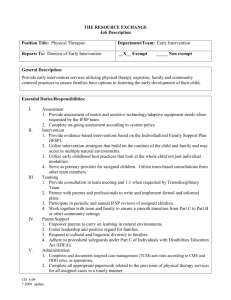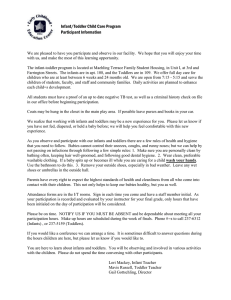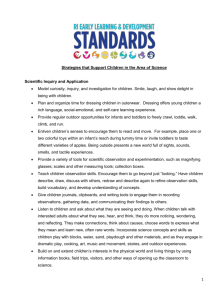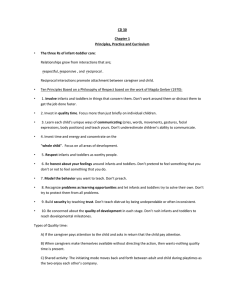21 Infants and Toddlers C H A P T E R Cathy Houston-Wilson
advertisement
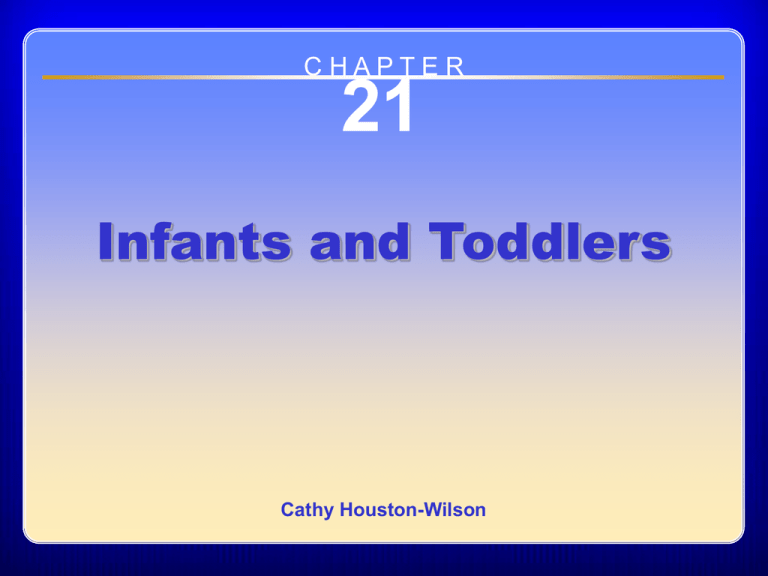
CHAPTER 21 Infants and Toddlers Cathy Houston-Wilson Chapter 21 Infants and Toddlers Legislation Related to Early Intervention for Infants and Toddlers • Education for All Handicapped Children Act Amendments (PL 99-457) • Individuals with Disabilities Education Improvement Act (PL 108-446) • As a result of these laws, children under the age of 3 who are experiencing delays in one or more functional areas are eligible for early interventions. Determining Eligibility • Experiencing delays in one or more of the following: cognitive, physical, communication, social or emotional, or adaptive behaviors • At risk for delays • Disability present (continued) Determining Eligibility (continued) • State established- each state is given the flexibility to determine specific criteria: For example in New York: a child is eligible if he/she is: -experiencing a 12 month delay in one or more areas -33% delay in one area -25% delay in two areas IFSP New York • 2 Standard deviations below the mean in one area. • 1 and ½ standard deviations below mean in 2 or more areas. IFSP • Use of assessment by a multidisciplinary team- use of a valid, reliable tests administered by trained professionals. • Data obtained and reviewed by the following: parents, service coordinator, professionals, advocates, others with an interest in the child Development of the IFSP Components • Present level of development • Family strength and needs • Measurable major outcomes to be achieved • Specific services • Dates and duration of services • Name of the service coordinator • Identification of transition services Role of Physical Educator in Early Intervention • Screen and assess motor development. • Determine eligibility for services related to motor development. • Develop motor goals and objectives for the IFSP. • Provide direct service. • Consult with early intervention providers and parents. Appropriate Forms of Assessment • Screening tests—informal and formal • Standardized tests • Curriculum-based assessments • Transdisciplinary Play-Based Assessment • Authentic assessments Goals and Objectives of Motor Programs for Infants and Toddlers • Enhance development of motor milestones and the acquisition of motor skills. • Provide opportunities for active movement by adhering to the guidelines for motor programs for infants and toddlers established by NASPE. • Create movement environments that are child centered and stimulate the child to act upon the environment. • Create environments that aid in the development of independence. Goals and Objectives of Motor Programs for Infants and Toddlers With Special Needs • Increase muscle tone and strength. • Decrease muscle tone and enhance reflex integration. • Stimulate the sensory motor system. • Enhance manipulative abilities. Developmentally Appropriate Interactions With Infants and Toddlers • Indirect teaching approaches – Teach from behind – Guided discovery – Free exploration • Child centered—child directed • Self-initiated repetition • Naturally occurring consequences Interacting With Families Family-centered physical education • Survey parents’ hopes and desires. • Teach parents developmentally appropriate ways to foster motor development. • Communicate with parents on a regular basis.

